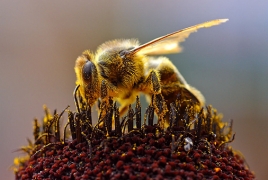
According to different sources, bees appeared 50 million or even 80 million years ago. Some scientists say bees emerged on the Earth more than 200 years ago, spreading across the globe and achieving various forms depending on climate and environment.
Bees that look like one another are actually different. Some have dark-colored hairy body while the others are light grey. Armenian bees are bright yellow. The queen bees are fertile and can lay up to 4000 eggs per day. Besides, their proboscis is rather long, reaching 7,2mm on average, which is 1mm more that others’. This peculiarity allows the Armenian bees to get nectar from the deepest flower-cups. The Armenian bees are hardy and can easily exist in hot weather.
Since the ancient times, bees have been the providers of honey, wax and propolis. However, they were also used as weapons. Extremely aggressive bees were kept to rebuff the attackers. Knowing about the peculiarities of Armenian bees, Arabs and Persians stole beehives during invasions.
In 1966, a reserve was created in Meghri for the breeding of Armenian bees. However, it isn’t currently functioning and there is a risk of losing this unique kind of bees.

